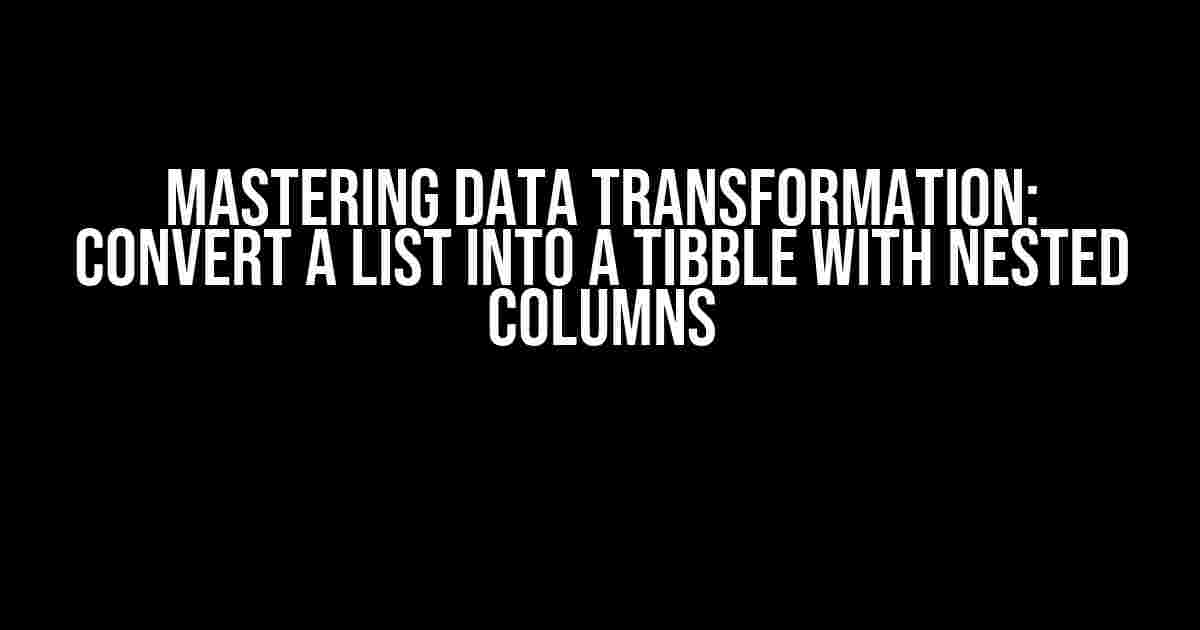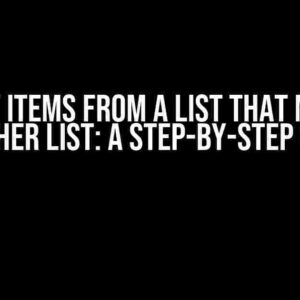Are you tired of dealing with messy data structures in R? Do you find yourself struggling to convert lists into tidy, analyzable data frames? You’re in luck! In this comprehensive guide, we’ll walk you through the process of converting a list into a tibble with nested columns. By the end of this article, you’ll be a pro at transforming your data into a format that’s easy to work with and analyze.
What is a Tibble, and Why Do I Need One?
A tibble is a type of data frame in R that’s designed to be more efficient and user-friendly than traditional data frames. Tibbles are part of the “tidyverse” suite of packages, which are designed to make data manipulation and analysis easier and more intuitive. Tibbles offer several advantages over traditional data frames, including:
- Faster data manipulation: Tibbles are faster and more efficient than traditional data frames, making them ideal for large datasets.
- Improved data visualization: Tibbles make it easy to create beautiful, publication-quality visualizations with just a few lines of code.
- More intuitive data structure: Tibbles use a more intuitive data structure than traditional data frames, making it easier to understand and work with your data.
Converting a List into a Tibble with Nested Columns
Now that we’ve covered the benefits of using tibbles, let’s dive into the process of converting a list into a tibble with nested columns. We’ll use the following example list:
my_list <- list(
id = c(1, 2, 3, 4, 5),
name = c("John", "Mary", "Jane", "Bob", "Alice"),
orders = list(
list(order_id = 1, order_date = "2022-01-01"),
list(order_id = 2, order_date = "2022-01-05"),
list(order_id = 3, order_date = "2022-01-10"),
list(order_id = 4, order_date = "2022-01-15"),
list(order_id = 5, order_date = "2022-01-20")
)
)
Our goal is to convert this list into a tibble with nested columns, where the "orders" column contains a list of orders for each customer.
Step 1: Load the Necessary Packages
Before we can start converting our list into a tibble, we need to load the necessary packages. We'll need to load the "tidyverse" package, which includes the "tibble" package, as well as the "purrr" package, which provides functions for working with lists.
library(tidyverse) library(purrr)
Step 2: Convert the List into a Tibble
Now that we've loaded the necessary packages, we can convert our list into a tibble using the "as_tibble()" function.
my_tibble <- as_tibble(my_list)
This will create a tibble with three columns: "id", "name", and "orders". However, the "orders" column will still be a list of lists, which isn't ideal for analysis.
Step 3: Nest the Orders Column
To nest the orders column, we'll use the "nest()" function from the "tidyr" package. This function takes a tibble as input and returns a new tibble with nested columns.
my_tibble <- my_tibble %>% nest(orders)
This will create a new tibble with two columns: "id", "name", and "orders". The "orders" column will now contain a list of tibbles, each representing a single order.
Step 4: Unnest the Orders Column (Optional)
If you want to unnest the orders column and create a separate row for each order, you can use the "unnest()" function. This can be useful if you want to perform analysis on individual orders.
my_tibble <- my_tibble %>% unnest(orders)
This will create a new tibble with three columns: "id", "name", and "orders". The "orders" column will now contain individual orders, rather than lists of orders.
Working with Nested Tibbles
Now that we've converted our list into a tibble with nested columns, let's explore some ways to work with this data structure.
Extracting Nested Columns
To extract a nested column, you can use the "pull()" function from the "tidyr" package. This function takes a tibble and a column name as input and returns a list of values.
my_orders <- my_tibble %>% pull(orders)
This will extract the "orders" column from the tibble and return a list of tibbles, each representing a single order.
Mapping over Nested Columns
To perform operations on each element of a nested column, you can use the "map()" function from the "purrr" package. This function takes a list and a function as input and applies the function to each element of the list.
my_summaries <- my_tibble %>% mutate(orders = map(orders, ~ summarise(.x, total_orders = n())))
This will create a new column called "orders" that contains a list of summaries, each representing the total number of orders for each customer.
Best Practices for Working with Nested Tibbles
When working with nested tibbles, it's essential to follow best practices to avoid common pitfalls and ensure that your data is tidy and analyzable.
Use Consistent Column Names
When creating nested tibbles, make sure to use consistent column names throughout your data. This will make it easier to work with your data and avoid confusion.
Avoid Deeply Nested Structures
Deeply nested structures can be difficult to work with and analyze. Try to avoid creating nested structures that are more than two levels deep.
Use Tibbles for Large Datasets
Tibbles are designed to handle large datasets efficiently. If you're working with a large dataset, consider using a tibble instead of a traditional data frame.
Conclusion
In this comprehensive guide, we've covered the process of converting a list into a tibble with nested columns. We've also explored some best practices for working with nested tibbles, including using consistent column names, avoiding deeply nested structures, and using tibbles for large datasets. By following these steps and best practices, you'll be able to transform your messy data structures into tidy, analyzable data frames that are ready for analysis.
| Before | After |
|---|---|
my_list <- list(
id = c(1, 2, 3, 4, 5),
name = c("John", "Mary", "Jane", "Bob", "Alice"),
orders = list(
list(order_id = 1, order_date = "2022-01-01"),
list(order_id = 2, order_date = "2022-01-05"),
list(order_id = 3, order_date = "2022-01-10"),
list(order_id = 4, order_date = "2022-01-15"),
list(order_id = 5, order_date = "2022-01-20")
)
)
|
my_tibble <- tibble(
id = c(1, 2, 3, 4, 5),
name = c("John", "Mary", "Jane", "Bob", "Alice"),
orders = list(
tibble(order_id = 1, order_date = "2022-01-01"),
tibble(order_id = 2, order_date = "2022-01-05"),
tibble(order_id = 3, order_date = "2022-01-10"),
tibble(order_id = 4, order_date = "2022-01-15"),
tibble(order_id = 5, order_date = "2022-01-20")
)
)
|
By following the steps outlined in this guide, you can transform your messy data structures into tidy, analyzable data frames that are ready for analysis. Remember to use consistent column names, avoid deeply nested structures, and use tibbles for large datasets. Happy data transforming!
Here is the HTML code for 5 Questions and Answers about "Convert a list into a tibble with nested columns" with a creative voice and tone:
Frequently Asked Question
Get ready to unleash the power of nested columns in your tibble!
How do I convert a list into a tibble with nested columns in R?
You can use the `nest()` function from the `tidyr` package to convert a list into a tibble with nested columns. For example, `df %>% nest(column1, column2)` will create a new column containing a list of values from `column1` and `column2`. Simply amazing, right?
What is the difference between `nest()` and `gather()` in tidyr?
While both functions are used to reshape data, `nest()` creates a new column containing a list of values, whereas `gather()` pivots data from wide to long format. Think of `nest()` as grouping data into clusters, and `gather()` as stacking data on top of each other!
Can I un-nest a tibble with nested columns?
Absolutely! You can use the `unnest()` function from `tidyr` to extract the nested data back into separate columns. For example, `df %>% unnest(column1, column2)` will expand the nested columns into separate rows. It's like magic, isn't it?
How do I access individual elements within a nested column?
You can use the `map()` function from `purrr` to access individual elements within a nested column. For example, `df %>% mutate(new_column = map(nested_column, ~ .x[[1]]))` will extract the first element from each nested list. It's like opening a present, but instead of paper, it's data!
What are some common use cases for nested columns in a tibble?
Nested columns are perfect for storing hierarchical or grouped data, such as survey responses, time series data, or network data. They're also great for creating data summaries or aggregations, like calculating group means or sums. The possibilities are endless, really!


